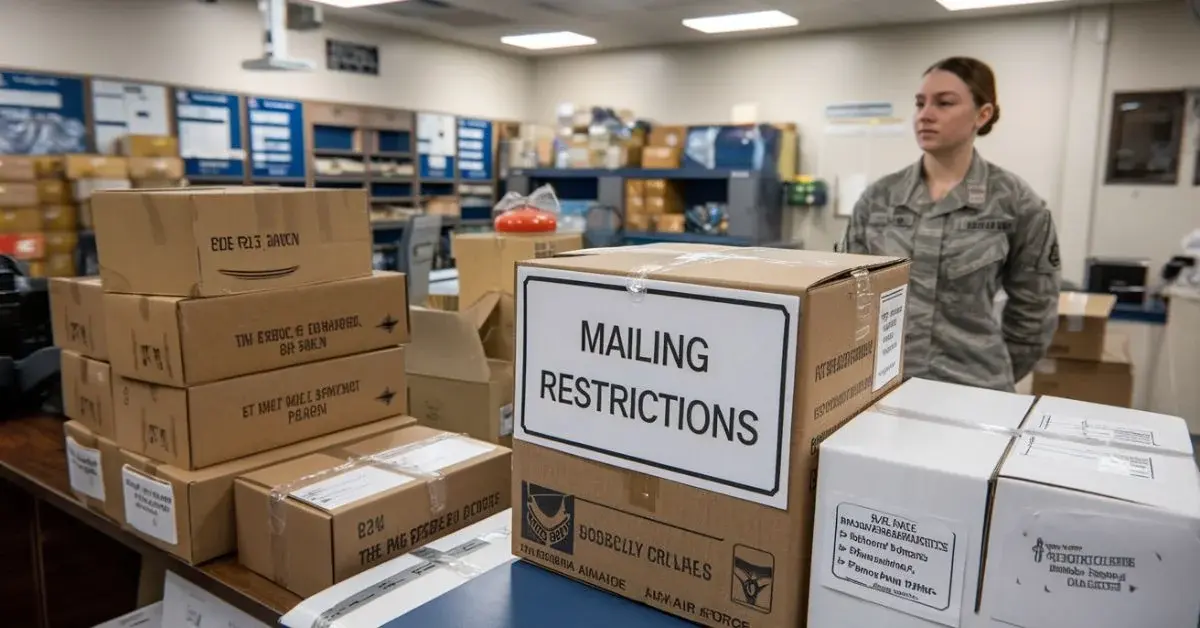This guide delves deep into the Air Force tech school mailing restrictions, ensuring you stay informed and compliant. Joining the United States Air Force (USAF) is a commendable decision, and attending a technical school is a crucial step in honing the skills necessary for various Air Force specialties. Whether you’re a recruit or preparing for a technical school assignment, understanding the mailing restrictions is essential.
Introduction to air force tech school mailing restrictions
Air Force tech schools are specialized training programs that equip Airmen with the technical skills required for their specific roles. These schools cover a wide range of disciplines, including:
- Cyber Operations
- Aircraft Maintenance
- Intelligence
- Medical Services
- Logistics
Each tech school has its own set of rules and regulations, especially concerning what can and cannot be sent via mail. Understanding these restrictions ensures that Airmen can maintain communication with family and friends without jeopardizing their training or security.
Why Mailing Restrictions Matter

Mailing restrictions are in place for several reasons:
- Security: Prevent unauthorized items from entering secure facilities.
- Safety: Avoid hazardous materials that could pose risks.
- Operational Efficiency: Ensure that mail processes do not interfere with training schedules.
- Compliance: Adhere to federal regulations and Air Force policies.
By adhering to mailing restrictions, Airmen contribute to a safe and efficient training environment.
General Mailing Policies
Before diving into specific restrictions, it’s essential to understand the general mailing policies of the Air Force tech schools:
- USPS Dominance: The United States Postal Service (USPS) is the primary carrier. While other carriers like FedEx or UPS may be used, they are subject to additional restrictions.
- Inspection: All incoming and outgoing mail is subject to inspection. This includes physical and electronic screening for contraband, hazardous materials, and prohibited items.
- Content Restrictions: Content deemed inappropriate, sensitive, or classified is strictly prohibited.
- Size and Weight Limits: Mail must adhere to specified size and weight restrictions to ensure it can be handled efficiently.
Prohibited Items
Understanding what cannot be sent or received is crucial. The following categories outline common prohibited items:
1. Hazardous Materials
- Explosives: Fireworks, ammunition, and other explosive devices.
- Flammable Items: Gasoline, lighter fluid, and other flammable liquids.
- Compressed Gases: Butane, propane, and other pressurized gases.
2. Weapons and Firearms
- Firearms: Guns, magazines, and parts thereof.
- Ammunition: All types of bullets and shells.
- Weapon Parts: Components that can be assembled into a weapon.
3. Drugs and Controlled Substances
- Illegal Drugs: Narcotics, stimulants, and other prohibited substances.
- Prescription Medications: Without proper documentation and authorization.
4. Pornographic Material
- Obscene Content: Any material deemed offensive or inappropriate.
- Child Pornography: Strictly illegal and subject to severe penalties.
5. Counterfeit and Pirated Goods
- Fake Currency: Any imitation of U.S. currency.
- Pirated Media: Unauthorized copies of software, movies, and music.
6. Perishable Goods
- Food Items: Without proper packaging and preservation.
- Plants and Seeds: Restricted to prevent ecological disruptions.
7. Hazardous Chemicals
- Toxic Substances: Pesticides, poisons, and other harmful chemicals.
- Radioactive Materials: Without proper licensing and containment.
8. Items Affecting Operational Security (OPSEC)
- Sensitive Information: Documents that could compromise security.
- Electronic Devices: Unauthorized gadgets that could be used for espionage.
Allowed Items and Guidelines
While many items are prohibited, several are permitted with specific guidelines:
1. Letters and Cards
- Personal Messages: Letters, postcards, and greeting cards.
- Affirmations: Encouraging messages from family and friends.
2. Books and Magazines
- Educational Material: Textbooks related to the tech school curriculum.
- Leisure Reading: Magazines and books for personal enjoyment.
3. Clothing and Personal Items
- Uniforms: Replacement parts for Air Force uniforms.
- Personal Care Products: Toiletries and hygiene items.
4. Photos and Memorabilia
- Photographs: Personal photos shared with family.
- Keepsakes: Small memorabilia items, within size restrictions.
5. Non-Hazardous Electronics
- Basic Gadgets: Approved electronics like radios or basic mobile phones.
- Accessories: Chargers and other non-prohibited accessories.
6. Educational Supplies
- Stationery: Pens, notebooks, and other writing materials.
- Study Aids: Flashcards and other learning tools.
7. Snacks and Non-Perishable Food
- Packaged Snacks: Chips, cookies, and other non-perishable items.
- Canned Goods: Without leakage and properly sealed.
8. Gift Items
- Small Gifts: Non-prohibited gift items like scarves or hats.
- Personalized Gifts: Items customized with non-sensitive information.
Guidelines for Allowed Items:
- Size and Weight: Must comply with the tech school’s specific limits.
- Packaging: Items should be securely packaged to prevent damage.
- Labeling: Clear labels with sender and recipient information.
- Quantity Limits: Restrictions on the number of certain items to prevent misuse.
Packaging and Labeling Requirements

Proper packaging and labeling are vital to ensure mail is processed smoothly and reaches its destination without issues.
Packaging Guidelines
- Durable Materials: Use sturdy envelopes or boxes to protect contents.
- Sealed Packages: Ensure all packages are securely sealed to prevent tampering.
- Cushioning: Use bubble wrap or padding for fragile items.
- Transparent Packaging: Where possible, use transparent materials for easy inspection.
Labeling Requirements
- Clear Addressing: Include full recipient address, including rank and unit.
- Return Address: Provide a complete sender address for return purposes.
- Labels: Use standard USPS labels and avoid handwritten addresses.
- Identification: Mark packages with “Do Not Bend” or “Fragile” if necessary.
- Tracking Information: Utilize tracking services for valuable or time-sensitive items.
Sending and Receiving Mail
Understanding the procedures for sending and receiving mail at air force tech school mailing restrictions is crucial for maintaining effective communication.
Sending Mail
- Preparation: Ensure all items comply with mailing restrictions and packaging guidelines.
- Documentation: Include necessary documentation for approved items like prescription medications.
- Drop-off Points: Use designated mailing centers or official channels to send mail.
- Tracking: Opt for tracking services for important packages to monitor their status.
Receiving Mail
- Inspection: All incoming mail is inspected for prohibited items.
- Notification: Airmen are notified of received mail, often through official channels.
- Collection: Pick up mail from designated areas within the tech school premises.
- Discrepancies: Report any missing or damaged items immediately to mailing authorities.
International Mail
- Customs Regulations: International mail must comply with both U.S. and destination country regulations.
- Prohibited Items: Stricter restrictions may apply; verify with the USPS International Mail guidelines.
Electronic Communication Alternatives
Given the strict mailing restrictions, electronic communication can be a reliable alternative for staying in touch.
Approved Platforms
- Email: Official channels provided by the Air Force for communication.
- Video Calls: Platforms like Microsoft Teams or Zoom are approved by the tech school.
- Messaging Apps: Secure messaging applications endorsed by the Air Force.
Benefits of Electronic Communication
- Speed: Instantaneous communication compared to traditional mail.
- Security: Enhanced encryption and security measures.
- Convenience: Accessible from multiple devices and locations.
Setting Up Electronic Communication
- Access Permissions: Obtain necessary permissions to use approved platforms.
- Training: Attend training sessions on using official communication tools.
- Compliance: Adhere to guidelines to prevent security breaches or misuse.
Consequences of Non-Compliance
Failing to adhere to mailing restrictions can lead to severe consequences, both personally and professionally.
Disciplinary Actions
- Counseling: Initial infractions may result in formal counseling sessions.
- Non-Judicial Punishment (NJP): Further violations can lead to NJP, affecting an Airman’s record.
- Court-Martial: Severe breaches, especially involving prohibited items, can result in court-martial proceedings.
Impact on Career
- Reputation: Non-compliance can tarnish an Airman’s reputation within the Air Force.
- Promotions: Violations may hinder opportunities for advancement and promotions.
- Security Clearances: Mishandling sensitive information can affect security clearance statuses.
Legal Ramifications
- Fines: Monetary penalties for violating federal laws.
- Imprisonment: Criminal charges for serious offenses like trafficking prohibited items.
Tips for Smooth Mailing Experiences
To ensure compliance and maintain effective communication, consider the following tips:
1. Stay Informed
- Regular Updates: Mailing policies can change; stay updated with official communications.
- Official Channels: Use official Air Force websites and resources for accurate information.
2. Double-Check Items
- Review Lists: Cross-reference items with prohibited and allowed lists before sending or receiving.
- Seek Clarification: When in doubt, consult with mailing authorities or superiors.
3. Proper Packaging
- Use Quality Materials: Invest in durable packaging to protect your items.
- Label Clearly: Ensure all labels are legible and correctly placed.
4. Limit Quantity
- Avoid Overloading: Do not send excessive quantities of allowed items to prevent suspicions.
- Diversify Items: Spread out items across multiple packages if necessary.
5. Utilize Approved Channels
- Official Mailing Centers: Always use designated mailing centers within the tech school.
- Authorized Carriers: Stick to USPS unless alternative carriers are explicitly approved.
6. Maintain Records
- Track Packages: Keep records of sent and received packages for reference.
- Document Communication: Save copies of important emails or notifications related to mail.
7. Respect Privacy
- Sensitive Information: Avoid sharing sensitive personal or operational information via mail.
- Secure Packaging: Ensure packages do not reveal confidential details through packaging or labeling.
Additional Resources
To further assist you in navigating Air Force tech school mailing restrictions, explore the following resources:
- USPS Official Website: Comprehensive mailing guidelines and services.
- Defense Logistics Agency (DLA): Resources on logistics and supply chain management within the military.
Conclusion
Navigating the mailing restrictions at Air Force tech schools may seem daunting, but understanding and adhering to these guidelines is crucial for maintaining effective communication and ensuring a smooth training experience. By familiarizing yourself with the Air Force tech school mailing restrictions, you can avoid potential pitfalls and focus on excelling in your technical education and military career.
Remember, the key to compliance is staying informed, being meticulous with what you send and receive, and utilizing available resources to address any uncertainties. For further assistance, always consult your tech school’s administrative office or refer to official Air Force publications.
Staying compliant not only safeguards your personal well-being but also upholds the integrity and security of the Air Force training environment. Embrace these guidelines, and embark on your Air Force journey with confidence and clarity.






Be First to Comment